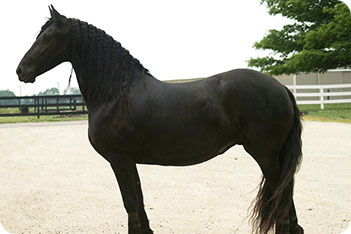
Equine De Gogue
From: Training Equipment
See Also: Draw Reins, Running Reins, Market Harborough and the Chambon.

De Gogue
This is a training device that encourages the horse to work in self carriage. The De Gogue has two settings one for lunging and another for ridden work.
Invented By
The De Gogue was invented by Frenchman Rene De Gogue.
Use
- To encourage correct muscle development.
- To ask for self carriage by encouraging the horse to use their muscles correctly.
- To release tension from the head, poll and neck.
Action
- The De Gogue applies pressure to the poll, corners, bars and the tongue.
- The De Gogue encourages the horse to work in self carriage without too much interference from the rider.
- When the horse is working in a correct outline the De Gogue will not apply pressure, when the horse shows resistance the De Gogue comes into action.
- When used for riding a set of De Gogue reins are used, these have several rings on the reins to which the De Gogue attaches, these rings can then be set for either a mild or strong action.
Fitting
- Lunging Use
- The De Gogue is attached to the girth and runs in between the front legs towards the horses chest.
- From the chest the De Gogue splits into two with each split running towards the bit rings.
- The De Gogue runs from the inside to the outside of the bit rings and then up along the cheekpieces to a poll attachment.
- From the poll each side the De Gogue then runs back down towards the chest where it rejoins and re attaches to the girth.
- Riding Use
- For riding the De Gogue starts off at the girth and runs in between the front legs towards the chest.
- From the chest the De Gogue then splits into two with each part running up to the poll attachment at the browband.
- From the poll it then runs down the cheek pieces and through the bit rings, before attaching to the D rings on each rein.
How to Use
- Lunging
- The horse should be suitably warmed up on both reins before the De Gogue is fitted.
- To begin with have the De Gogue set for mild use, so that the horse can gently accustom themselves with the pressure that is applied when De Gogue comes into action.
- Once the horse is used to the pressure the De Gogue can be gradually tightened to encourage the horse to use itself correctly.
- The horse should then be worked actively forwards on both reins.
- Ridden Use
- Have the De Gogue set on the lowest ring to begin with then once the horse is accustomed to the pressure, the rings on the reins can be adjusted to the required length.
- Warm the horse up on a very light contact at first to ensure that the horse is moving actively forwards and is warmed up, then the rider can start to take more of a rein contact.
- If the horse shows any sign of discomfort or panic from the De Gogue pressure then the rein should be immediately relaxed and the De Gogue re-adjusted.
- Use the De Gogue to assist you with training your horse, where possible reduce the setting so that the De Gogue can be completely removed once the desired result has been accomplished.
Safety Precautions
- Gradually introduce the De Gogue by using a mild setting to begin with and correctly warming the horse up before use.
- If the horse shows any sign of discomfort or panic then the De Gogue rein should be released to immediately reduce the pressure that is being applied.
- Try where possible to avoid using the De Gogue all the time remembering that it is only a training aid.
- Only to be used by experienced riders.
- If you have not used a De Gogue before then seek professional advice.